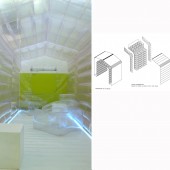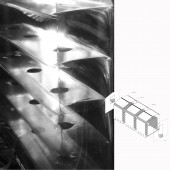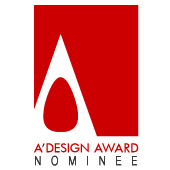DESIGN NAME:
minimum post disaster dwelling
PRIMARY FUNCTION:
Post Disaster House
INSPIRATION:
house is like a dress that is possible to wear
UNIQUE PROPERTIES / PROJECT DESCRIPTION:
transparent modular simply small house that is also very liight
OPERATION / FLOW / INTERACTION:
-
PROJECT DURATION AND LOCATION:
There is not one location, invisible house is like an address that goes with individual.
FITS BEST INTO CATEGORY:
Building Materials and Construction Components Design
|
PRODUCTION / REALIZATION TECHNOLOGY:
The structure, entirely transparent and aligned with a traditional house style, is based on the principle of modulation. In fact, it is composed of three inflatable elements measuring 2.50m. length, 2,30m. height and 1.5 m. thickness.
Modules, anchored on the ground by a system made of steel platforms, are assembled together through zip closings, and set in such a way as to prevent that water sooks into the walls. Once the length of the house has been determined, each module is concluded in non-inflatable plugging panels, that can contain a door or window as needed. These last elements themselves, which allow for the ventilation of the internal space, are characterized by a side zip closing system.
We think to provide the structure with elements that would also be inflatable and transparent, to respond to the project intentions: armchairs, sofas, beds, tables, showers etc. Electric energy will be provided by the use of amorphous silicon modules, set on the inclined external surface south oriented by means of a system of prefabricated zip closings that will need to be prefabricated, as indicated in the project.
SPECIFICATIONS / TECHNICAL PROPERTIES:
House size: 10 mq
TAGS:
temporary house, transparent house, post disaster house, modular structure
RESEARCH ABSTRACT:
altro_studio’s research
Our architecture can be defined experimental that is we experiment the impact a particular space has on people. Those effects, mainly related to the phenomenological and perceptive aspect, as Merleau Ponty meant, take their inspiration from a series of phenomena inherent to the contemporary reality that influence the conception of the living space by changing the individual behaviour living space is meant both public and private).
We are talking about phenomena permeating the urban area (mobility, speed, complexity, etc…), natural phenomena (desertification, floods, earthquakes), or events concerning the whole world which, even interacting with different cultures and races, all share common elements underlined by terms such as information, consumerism, emigration, globalizatio. Our research is therefore intended as a possible response to a series of events, or, in some cases, rather like predictions sometimes approaching utopian solutions.
We often wondered how it was possible to reach abstract solutions, forecasting future whether immediate, even starting from real elements. The answer lies in what we mean by ‘real’ talking about a specific phenomenon.
Moreover going beyond the event itself, that is pushing the phenomenon to its limits, new conditions, completely apart from reality, arise.
Given that you can say that we are working on extreme spaces, which set apart the architectural rules, spaces according to which the concept of phenomenon is influenced by some fundamental philosophical theories (Foucault, Deleuze, Merleau Ponty) based on the connection environment-subject-individual, but also by mathematical or scientific rules, which have always been considered instrumental for the architecture.
We thus work on spaces characterized by those contrasts that are usually part of the written and spoken language. Closed-opened, outside-inside, visible-invisible, chaos-order, rational-organic, under-above, etc. These are contrasting terms often matter of philosophical enquiry throughout history) that never reach the point of balance which was typically related to tradition (in the classic age they searched for the balanced proportions, for the balance between empty and full etc.). Indeed they exist just through conflict and contrast producing various new tensions which make people confusing within a confused reality. to reach extreme special conditions we use the movement as an instrument that shows a complex, but most of all, non static architecture.
Individual movement-nomadic architecture
We base our research on this matter along two main directions: the individual movement, which refers to the wandering space and which is represented by the empty, the smooth space on which the visual perception is based and in which the fundamental element is the route. Crossing the territory the individual perceive the space so architecture becomes a cloth to wear and to bring with us, to be soon left on the territory once used.
Movement of architecture-one family houses
The movement of architecture as it acquires subjectivity replacing the individual.
Moving parts and elements through operations such as rotating, sliding, flowing, overturning etc. it is possible to reach infinite spatial conditions in a short time no one of which prevail. In computer age the domestic spaces becomes, at same time, private and public. With computer we can to work, to spick, to get research, to buy all we need, to get video-conference.
According to us this represents an alternative and different way of perceiving the space in which architecture expresses itself, not only through the searching for a form, which for us has a deductive character, but through pure and simple gesture. Just through action you can always reach different expressions.
To stress this concept, our architecture assumes a poor character; we use simple and essential forms, supported by the use of materials that are simple and economical.
All this does not exclude the scenic and illusory side of architecture, through this real use of its daily gestures: sliding serigraphic glass doors, drawing rotating walls, lighting elements that, moving change the perception of the space and create unique optical effects. Each structure becomes a theatrical work with no end and no beginning and without a specific plot, indeed it expresses without a script. In this sense we can define all our projects as ‘kinetic architecture’
It is interesting the study and the resolution of the architectural detail related to the composition rules. For example the ‘Mies Van der Rohe’s cross pillar is divided into four parts to let the walls slide, or the volume itself is broken to reach the same effect.
New living types arise such as the semi-duplex, the double-face space and the holo-space, etc. Finally it is fundamental to notice that all structures are thought as the right answer to bio-compatibility and self-sufficiency. In particular the first group of architectures (architecture of movement) is characterised by natural and recycled materials while the second group (architecture in motion) is defined through automation systems, intelligent systems able to answer to the new technological living comforts.
Movement of architecture-living units. Specifically, our plan points to the analysis of the effects that a space or more spaces, defined as extremes, produce not only on a single individual but on a group of individuals, considered true and actual spectators of a probable event. In contrast to the previous projects, essentially tied to the principle of abstraction, these projects depend on the situation in which they are set, meaning the all the local conditions to which they are bound, for example to tradition, surrounding physical space, culture, history and the environment. These considerations, which seem to be aligned with Norberg-Schulz’ ideas, acquire a specific character as place is not considered just one thing together with the project, but as a field of action where, through the same project, it becomes possible to generate a conflict. This contraposition gave architecture its origin. For example the menhir and the dolmen are nothing but the result of this conflict: between nature and artifice, between vertical and horizontal, between inside and outside, etc… Generally speaking, the projects that we will introduce are based on the principles of typological and spatial flexibility, on innovative technology, on functional hybrids and above all on the tracking down of new living types aligned with the aspects linked to bio-climate and automation, recurrent instruments in our research.
To consider living unit in computer age means to have no more collective or public spaces becouse we find them inside domestic places. It is new society considered as addition of self-sufficient individuals, not as a traditional community. In this way our city will contains
underground levels were stands a big warehouses from where all kind of goods reach the lodgings through the elevators (useful system for online shopping)
CHALLENGE:
idea is based on nomadic architecture concept. in this case house must be light, tranparent, for to see all the world.
ADDED DATE:
2014-06-22 10:47:00
TEAM MEMBERS (1) :
IMAGE CREDITS:
altro_studio, 2014.
|









